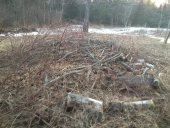We are raising chickens for the first time in a long time this spring. We ordered day old chicks - 15 layers (Red Stars) and 15 cornish rock crosses for meat birds. I raised these babies in our dining room for 4 weeks until they were big enough to go outside to their new coop and yard. In those 4 weeks I handled them almost daily, looked them over for signs of illness, made sure they were warm enough and had clean water, even washing their little butts when some of them pasted up. By the grace of God and my hard work I didn't lose a single one.
After a few weeks in the coop I could see that my meat birds were growing uncomfortably large (I won't be ordering Cornish crosses again for this reason) and the time had come to put up or shut up. I approached the processing like I had approached getting the birds int he first place: reading everything I could, watching YouTube videos, and mentally going over the proceedure in my mind. It helps that I'm in the medical profession and have spent a fair amount of my life in the ER and OR. I prepped for processing day the same way I prepped for a new procedure in the OR. And in the same way I struggled to find a place of clinical detachment that would allow me to approach the act with respect and confidence and competence.
The first bird went into the calming cone (we don't call it a killing cone), and as the bird relaxed so did I. We thanked it for the sacrifice it was borne to make on behalf of our family and expressed hope that we had made its short life as comfortable and enjoyable as a chicken's life could be. We went slow and stepwise and I found that my wife and I grew closer though the process and through talking about our thoughts and emotions while doing it.
It is not for everyone. It may not be the right time for you guys to do this yet. If you cannot do it yourself at least hire it done (the processing that is) and raise your own meat if you plan to eat meat. Your family will advance along the path at your leisure. We found that by going to a friends and helping with their processing it was WAY easier for us to do it ourseles knowing the process better. YMMV




